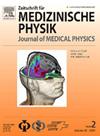为临床前照射正位胰腺肿瘤开发 PTV 边界,该边界源自著名的人体配方。
IF 4.2
4区 医学
Q2 RADIOLOGY, NUCLEAR MEDICINE & MEDICAL IMAGING
引用次数: 0
摘要
在人类放射治疗中,安全裕度(PTV裕度)是成功照射的必要条件,通常也是临床治疗计划的一部分。在使用小动物进行临床前放疗研究时,也存在着大多数不确定性和不准确性,但根据文献资料,很少使用安全边际。此外,关于边缘的适当大小也鲜有经验可循,这一点应仔细研究和考虑,因为这将影响对危险器官或正常组织的保护。在此,我们根据小动物辐射研究平台(SARRP)上标本的尺寸和要求,对 van Herck 等人的著名人体边缘配方进行了调整,从而估算出临床前辐照所需的边缘。我们根据正位胰腺肿瘤小鼠模型所面临的具体挑战调整了所述公式中的系数,以建立适当的边缘概念。SARRP 可在图像引导下进行弧形照射,照射野大小为 10 × 10 平方毫米,共照射 5 次。我们的目标是用至少 95% 的规定剂量照射至少 90% 的小鼠的临床靶体积(CTV)。通过仔细分析所有相关因素,我们将临床前设置的 CTV 与规划靶体积 (PTV) 的裕度定为 1.5 毫米。所述安全裕度在很大程度上取决于实验的具体设置,必须根据其他实验设置进行调整。文献中给出的几个数值与我们的结果非常吻合。尽管在临床前设置中使用安全裕度可能是一个额外的挑战,但我们认为使用安全裕度对产生可靠的结果和提高放疗疗效至关重要。本文章由计算机程序翻译,如有差异,请以英文原文为准。
Development of a PTV margin for preclinical irradiation of orthotopic pancreatic tumors derived from a well-known recipe for humans
In human radiotherapy a safety margin (PTV margin) is essential for successful irradiation and is usually part of clinical treatment planning. In preclinical radiotherapy research with small animals, most uncertainties and inaccuracies are present as well, but according to the literature a margin is used only scarcely. In addition, there is only little experience about the appropriate size of the margin, which should carefully be investigated and considered, since sparing of organs at risk or normal tissue is affected.
Here we estimate the needed margin for preclinical irradiation by adapting a well-known human margin recipe from van Herck et al. to the dimensions and requirements of the specimen on a small animal radiation research platform (SARRP). We adjusted the factors of the described formula to the specific challenges in an orthotopic pancreatic tumor mouse model to establish an appropriate margin concept. The SARRP was used with its image-guidance irradiation possibility for arc irradiation with a field size of 10 × 10 mm2 for 5 fractions. Our goal was to irradiate the clinical target volume (CTV) of at least 90% of our mice with at least 95% of the prescribed dose. By carefully analyzing all relevant factors we gain a CTV to planning target volume (PTV) margin of 1.5 mm for our preclinical setup.
The stated safety margin is strongly dependent on the exact setting of the experiment and has to be adjusted for other experimental settings. The few stated values in literature correspond well to our result. Even if using margins in the preclinical setting might be an additional challenge, we think it is crucial to use them to produce reliable results and improve the efficacy of radiotherapy.
求助全文
通过发布文献求助,成功后即可免费获取论文全文。
去求助
来源期刊
CiteScore
3.70
自引率
10.00%
发文量
69
审稿时长
65 days
期刊介绍:
Zeitschrift fur Medizinische Physik (Journal of Medical Physics) is an official organ of the German and Austrian Society of Medical Physic and the Swiss Society of Radiobiology and Medical Physics.The Journal is a platform for basic research and practical applications of physical procedures in medical diagnostics and therapy. The articles are reviewed following international standards of peer reviewing.
Focuses of the articles are:
-Biophysical methods in radiation therapy and nuclear medicine
-Dosimetry and radiation protection
-Radiological diagnostics and quality assurance
-Modern imaging techniques, such as computed tomography, magnetic resonance imaging, positron emission tomography
-Ultrasonography diagnostics, application of laser and UV rays
-Electronic processing of biosignals
-Artificial intelligence and machine learning in medical physics
In the Journal, the latest scientific insights find their expression in the form of original articles, reviews, technical communications, and information for the clinical practice.

 求助内容:
求助内容: 应助结果提醒方式:
应助结果提醒方式:


